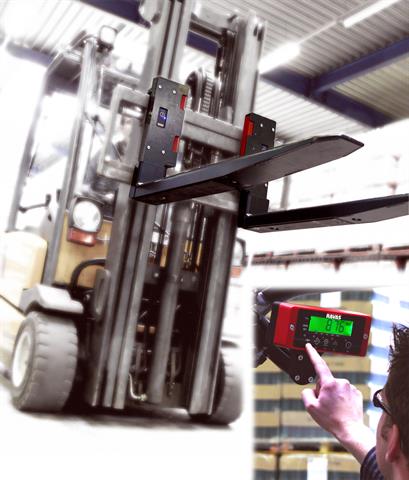 RAVAS iForks and indicator |
SOLAS Method #2, computing VGM container weights, has proven especially attractive to 3PLs that consolidate LCL shipments. Inbound shipments are weighed and registered on the lift truck that offloads them. The ERP calculates container weight when compiling the loading list.
Weighing individual shipments in containers: better ROI and flexible logisticsOn July 1st of this year, the
SOLAS amendments pertaining to container weights have become effective. Shippers of sea containers are now required to declare the VGM (Verified Gross Mass) of the container to the terminal and the shipping line, before the container is loaded onto a vessel. If the VGM is not communicated, the container is not taken onboard. The goal of the SOLAS regulation changes is of course to increase the safety of the ever larger container ships, by giving the carrier the tools to create accurate stowing plans.
The IMO (International Maritime Organisation), who is responsible for drawing up SOLAS regulations, has decided that two methods for determining the weight of containers are permissible: weighing the complete packed container
(Method #1), or weighing the individual items in the container and add the container tare weight to compute the VGM
(Method #2).
It is Method #2 that has gained popularity with 3PL providers. Reason is first that information becomes available on individual LCL shipments within a container, and second that the weight of individual LCL shipments can be determined at any point in the handling process, making VGM information available early and leaving complete freedom in designing internal logistics.
Weighing inbound shipments on connected forklift trucksThe
iForks forklift scale is the weapon of choice for many 3PLs. Inbound individual LCL shipments are identified and weighed on the forklift that offloads them, without taking the goods out of the process. The weight data is
communicated with the ERP or WMS. During the planning stage the ERP compiles the loading list for a container: it simply adds up the registered weights of individual shipments on the list and adds the container's own weight, to compute the VGM. Thus the weight of the packed container is known before a single pallet is loaded into it. There are numerous advantages to this way of working. If the weighing is done when the goods are inbound, weight information becomes available early on in the process, ensuring timely communication of container VGM's to the shipping line and leaving time for changes or corrections involving the sender of the goods. Since the weights can essentially be sampled anywhere in the handling process, logistic bottlenecks during the loading of a container (typically done during peak hours) are avoided. The 3PL retains complete freedom in defining his internal logistics.
SOLAS Method # 2: lower initial investment, better ROIThe initial investment for a forklift scale is low, especially when compared to a weighbridge for weighing complete packed containers on outbound freight trucks. In addition, weighing LCL shipments on forklifts brings extra advantages that contribute to a faster ROI. Since individual shipments are weighed, they are always invoiced for the correct amount, usually adding revenue. And since the forklifts weigh anyway, they will also check the weight of shipments not destined for container shipping, but for road transport, optimizing both revenues and load factors.
Get connected with the iForks forklift scaleiForks is the wireless mobile scale for forklift trucks from
RAVAS. With iForks on the truck, every load lifted is immediately weighed. iForks provide a highly accurate weight read-out on a display in the cabin, and can communicate weight data with WMS or ERP systems, via
Bluetooth or Wifi connection. iForks can be installed on any counterbalanced or reach truck in a matter of minutes and are available in legal for trade version OIML III. Extended scale functions include registering of ID codes with every weight recorded.
For off-line computing of container weights, RAVAS offers its
SOLAS App. The App can be installed on a PDA, iPad or iPhone. After identifying the container by its number and registering its tare weight, the App allows the user to identify individual pallets or shipments and register their weight, communicated by
iForks. Total container weight is computed and registered on the PDA, and can be downloaded to a PC via USB cable, as a CSV file. If the
App is used on an iPad or iPhone, the information can be e-mailed to the shipping line straight from the App.
If you have questions about SOLAS regulations and container weights, visit this
FAQ page or if you would like more info on
iForks, please contact us!
RAVAS Europe BV
P: +31 418 515 220
E: send an email
W: www.ravas.comAbout RAVAS
RAVAS manufactures and distributes weighing systems integrated in hand pallet trucks, warehouse trucks and forklift trucks. These mobile weighing systems enable companies to realize immediate cost savings, to make their internal logistics more efficient, to raise the quality of their products and services and thus increase client satisfaction. In today's world of integrated information RAVAS strives to give all its products optimal connectivity. This means that weight information from RAVAS mobile scales can be easily integrated with other information about material flows. The resulting data set can be fed directly into an ERP or WMS system.